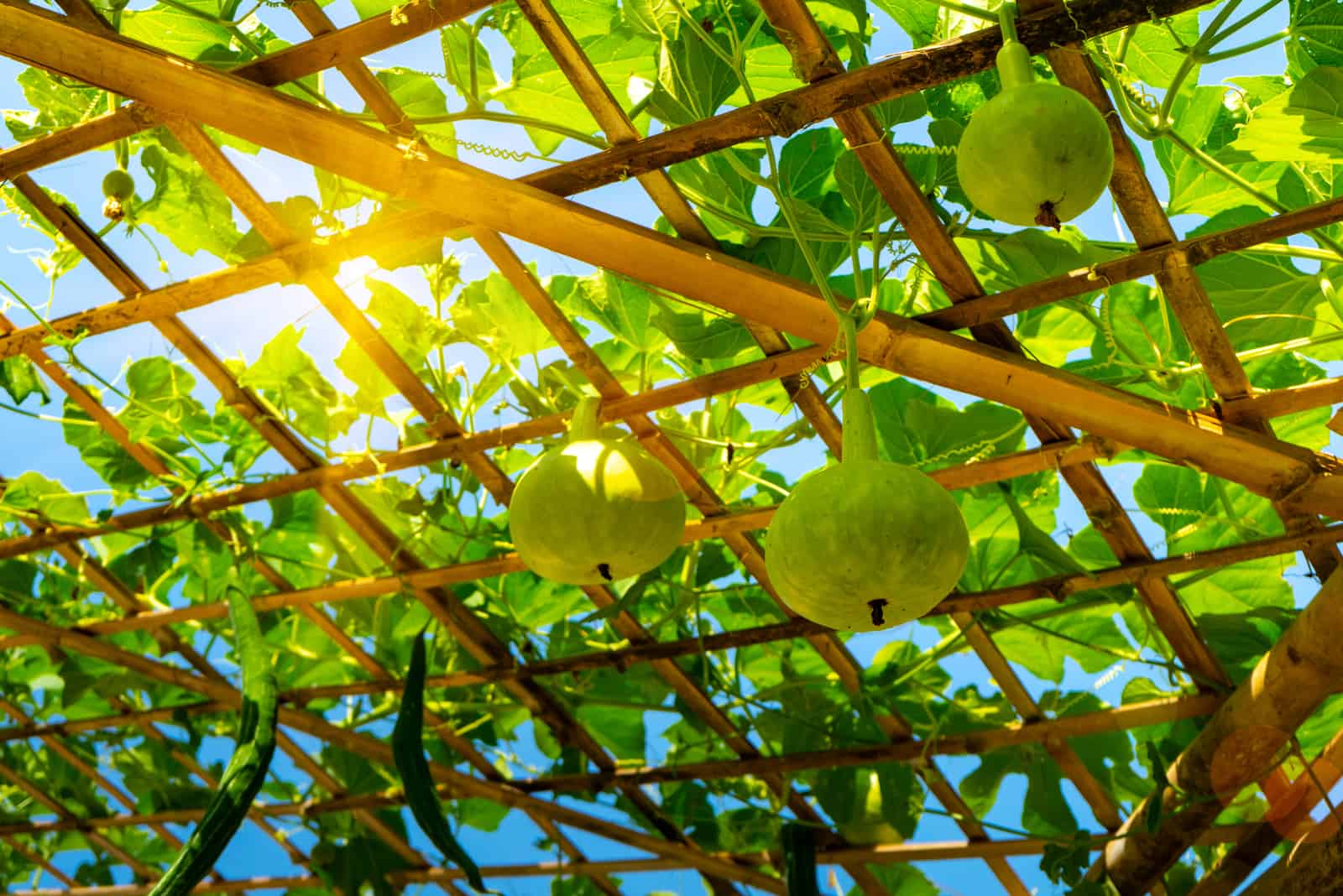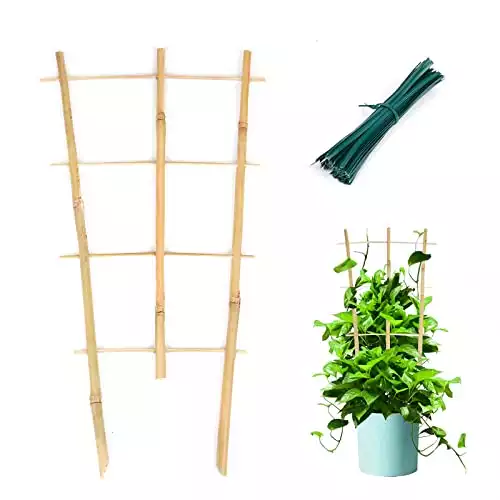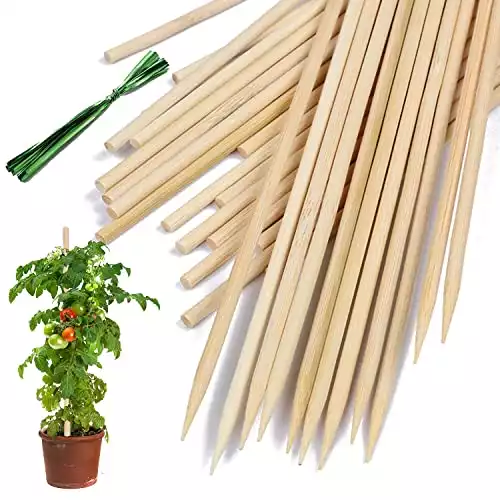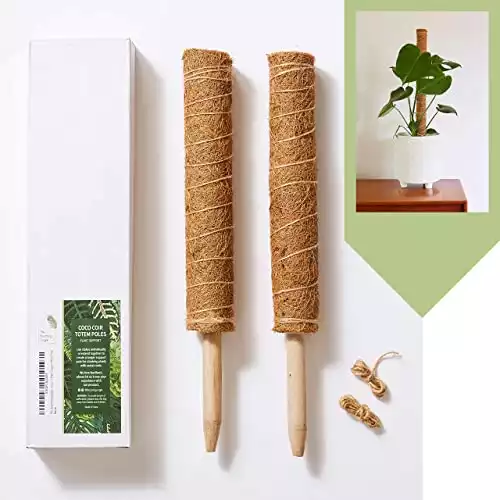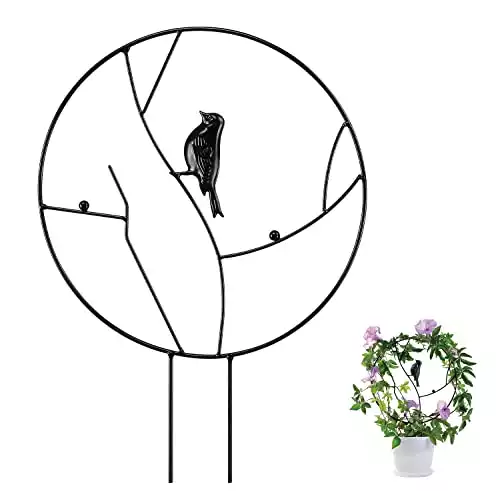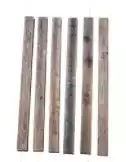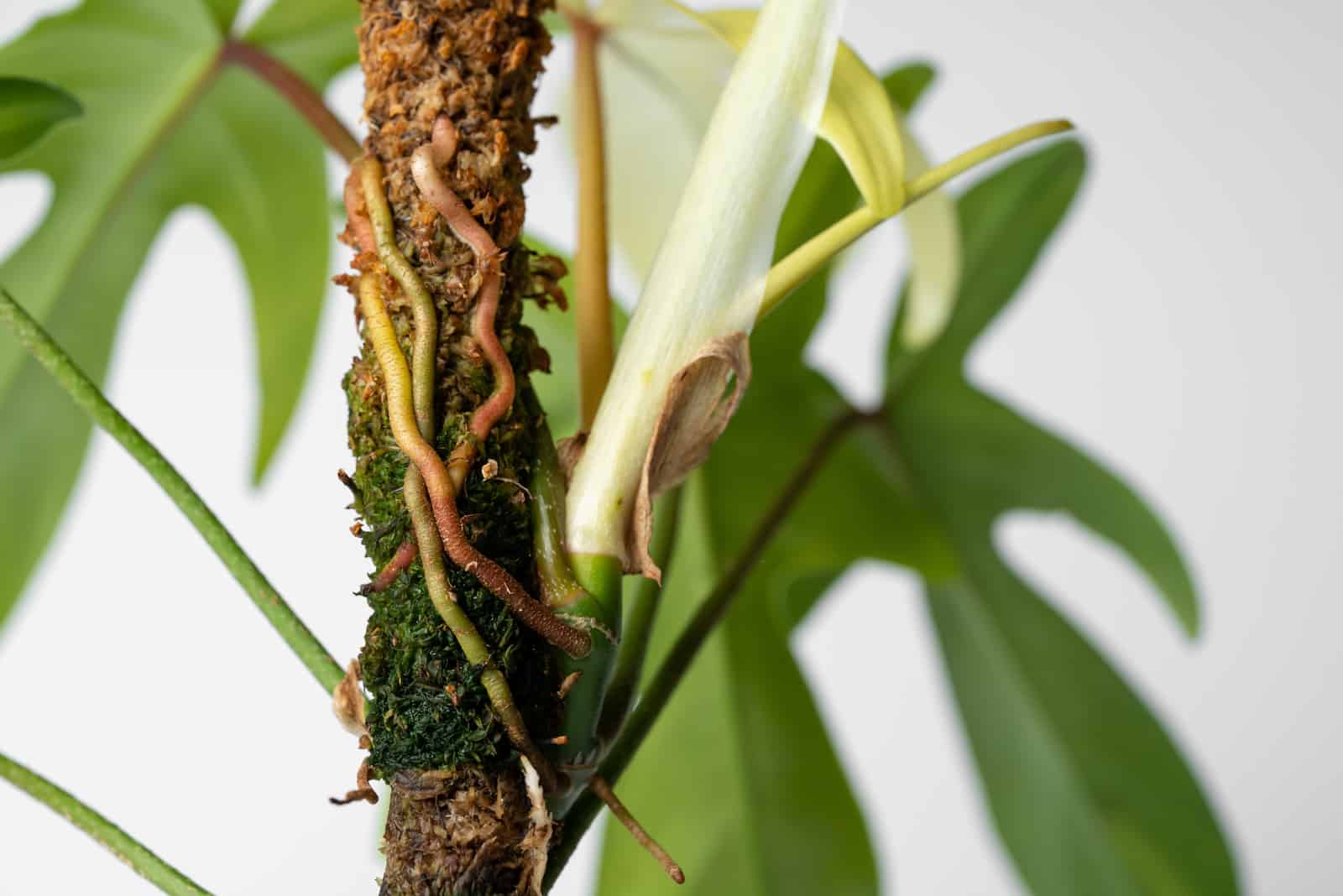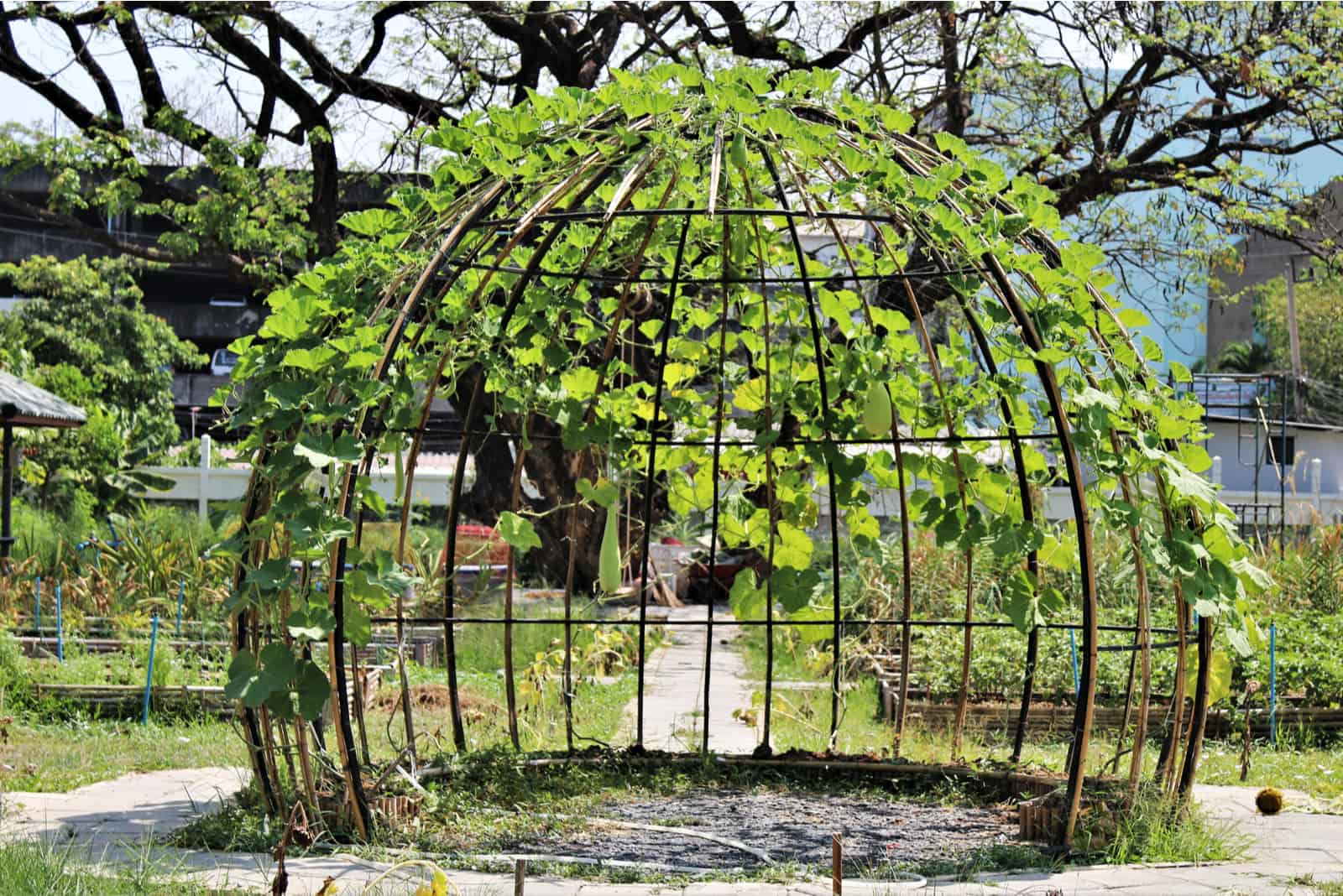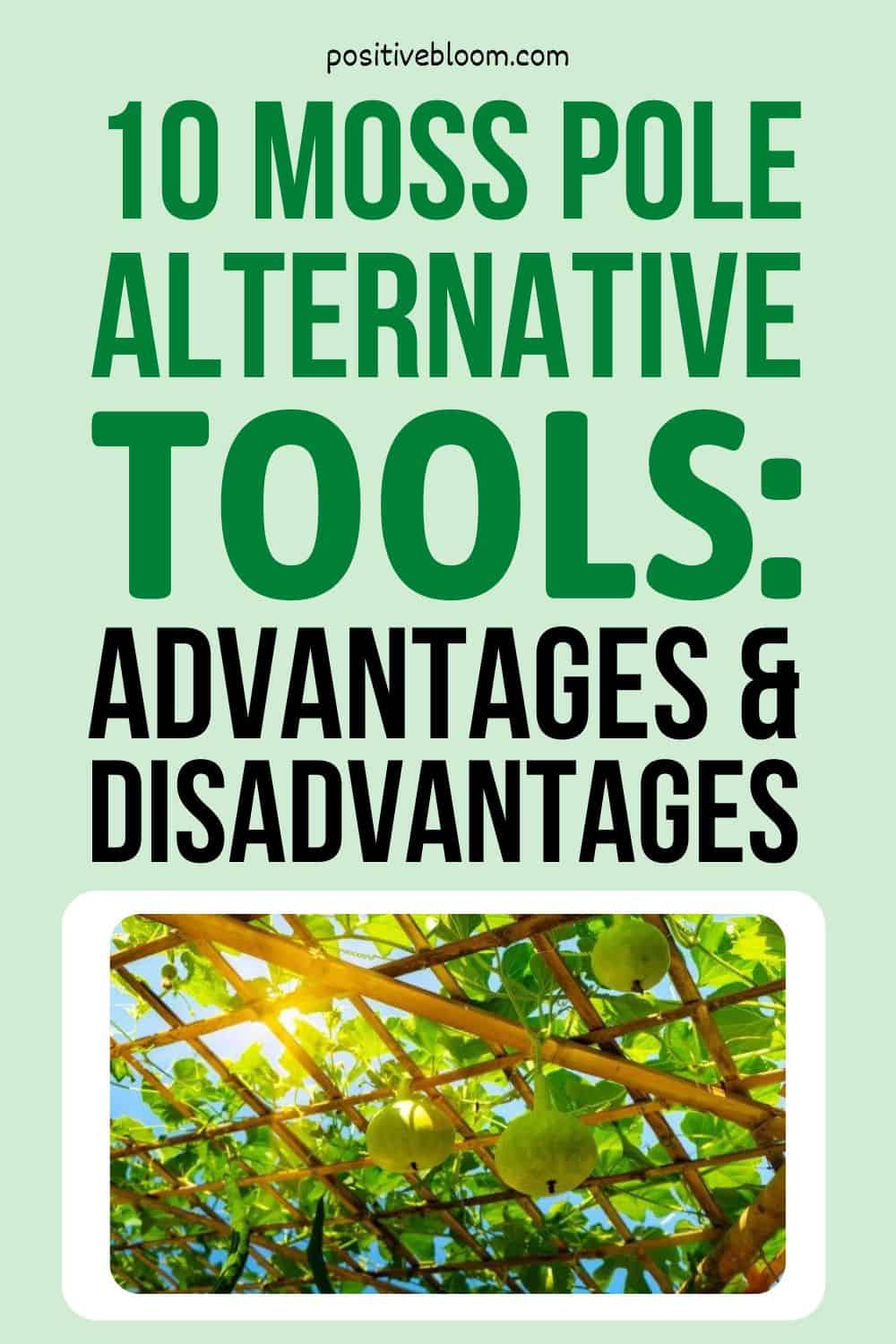Positive Bloom is an Amazon Associate and we earn from qualifying purchases through these links at no extra cost to you.
Climbing plants, such as different varieties of pothos, monstera deliciosa, and philodendron, require moss poles, or other stakes, for healthy and speedy growth.
Even though there are some great moss poles out there, some are simply not up to the task and can deteriorate rather quickly.
For that reason, we’ll bring you our ten favorite moss pole alternative tools that you can make yourself and that have all the benefits of a store-bought pole.
You will need several different materials, such as jute, glue, and some trellises, but once you start getting crafty, you won’t be able to stop making your own stakes.
Let’s get started!
10 Moss Pole Alternative Tools
Moss poles are great supporting tools for all kinds of vining plants, but they are simply not widely available.
Those that we came across in markets were super expensive, messy, and not worth the money.
However, there are alternatives to moss poles that you can explore, and we’ve examined the pros and cons of some of our favorite ones.
Also, we’ve been asked many times, “How to make a moss pole at home?” so we’ve decided to make this article interesting and crafty and we’ll bring you some great tips for preparing some of the best moss poles (and the best alternatives to moss poles) at home.
1. Bamboo Troellis
Bamboo trellises are our favorite alternative to moss poles, especially if you grow hoya plants or philodendrons.
You can order simple bamboo plant stakes or go for a more engaging, ladder-like design, such as this one:
• The stick is 0.19 inch in diameter,strong and durable;
• Lightweight stakes have smooth;
• Per pack of 25
If you buy simple bamboo stakes or canes, you can always get creative and make a fun shape that will attract many glances and start many conversations.
You simply have to connect the stakes with some lashing cord and place it in an empty pot or container before adding soil and potting your new plant.
Bamboo Trellis Pros And Cons
There are many advantages to using bamboo poles. They are eco-friendly, stylish, sustainable, reduce pollution by producing oxygen, can act as a water barrier, and even increase the yield of your veggies.
They are also naturally resistant to pests, but, unfortunately, there are some disadvantages when they’re compared to moss poles.
They are susceptible to fungus infections if not taken care of; they shrink more than tree wood and can even pierce the root systems of potted plants.
2. Wooden Stake
Many care guides recommend that you stake your climbers, and wooden sticks or stakes are a great, cheap option.
You can use them alone, but you won’t get the best results that way. However, we use a wooden stake as a base for our DIY moss pole.
You need coco coir (coconut fiber), sphagnum moss, and some jute to connect all the materials.
Shape the wooden pole however you wish, but if you’re experiencing creativity block, you can simply leave it as it is and wrap it in moss.
Then, fasten the moss to the pole using a piece of jute, and ensure that it’s really tight. And that’s it; your aroid climbers will now be able to enjoy their renovated homes.
Wooden Stake Pros And Cons
Some of the advantages of using wooden sticks instead of ready-made moss poles are that they are cheaper, more reliable, and sturdier. They are lightweight, easy to set up and use, and cannot be damaged easily.
However, wooden stakes are definitely not bug-resistant, and there is a high possibility of pest infestation, which reduces the durability of both the plants and poles.
Also, they are a fire hazard, so you should be careful where you put them.
3. PVC Pipe
Using PVC pipes as a homemade plant support is an ingenious way of giving your epiphytes what they want.
Simply wrap sphagnum moss around it and secure it with a plastic net or twist ties. You can even create a self-watering moss totem if you drill holes in the PVC pipe.
Holes in the PVC pipe will ensure that the moss is constantly moist, so you won’t have to worry about misting it every now and again.
Simply cut the PVC pipe to the size you want, and drill the holes in it (if you wish to make a self-watering pole).
You can also use a cotton rope to make a knot, insert it through the pipe, wrap the cord around it, and secure it with cable ties. When you fill the pipe with water, the rope will get wet and transfer the moisture onto the moss.
The next step is to put some moist moss on the plastic mesh and wrap the pipe with it, fixing it with cable ties. We use eesh, roughly the color of the moss so that it doesn’t stick out too much.
Cap the bottom of the pipe with a waste pipe stop, so that water from the pipe cannot flow out and clog the soil.
Finally, you can check out the video below if you need any help making your first self-watering pole.
Knowing how to stake your monstera might be difficult at first, but with a little bit of practice, everything is possible.
Pipe Pros And Cons
PVC pipe is not made of natural material, and that has its own perks. It’s durable, stands upright, is easy to install, and can be reused.
One of the main benefits of using PVC is that it cannot get attacked by pests or infected by fungus diseases. Also, when you cover it in moss and plastic wrap, it does gain a natural look that can fool anyone.
Like everything else in this world, there are certain disadvantages to using PVC pipes for staking your monstera plants.
It can easily crack and cannot endure higher temperatures; it melts at high temperatures, and it cannot decompose, which makes it an infamous pollutant.
It doesn’t contain any nutrients that the plants could benefit from, and it can even leak some chemicals that aren’t preferable into the soil.
However, it all comes down to you to decide whether the pros outnumber the cons.
4. Coir Pole
A Coir pole is our personal favorite alternative to moss poles, and our house plants seem to love it.
Coir is a natural coconut fiber made from the husk of a coconut and your plants’ aerial roots can easily penetrate it.
We love this product from Amazon as it comes with two poles, so you won’t have to worry about your plants outgrowing it.
However, if you’re like us and love arts and crafts, then you might want to know how to make your own moss pole substitute.
All you need is a stake and some coir material. We usually choose a pipe or something similar that’s just lying around the house. Spray the coir with water and secure it with brown string or jute, as white string can be a real eyesore.
Also, leave around 6 inches (15 cm) of free space at the base, so that you can place it in the ground.
We realize that making your first pole might be difficult, but you can check out the following video for further instructions.
Coir Pole Pros And Cons
One of the main benefits of coir poles is that they can enhance a plant’s capacity for water retention, since the coco material is highly porous.
These poles are suitable for both indoor and outdoor gardening, and plants can grow naturally, since their aerial roots can grip the material tightly.
The coir poles are eco-friendly, strong, and can ensure faster growth in plants that love to grow vertically.
But, nothing in this world is perfect, including coir poles. They produce way too much salt, which is potentially harmful to plants.
They last for about two to four years, and if you’ve switched from a moss to a coir pole, you should repot your plants and change the fertilizer as well.
5. Metal Mesh
Metal mesh is something we’re used to seeing in vegetable gardens, but if you shape it into cylinders, it can make a unique pole for climbing tropical plants.
Cages are not appealing, but cylindrical poles are an excellent option when you’re surrounded by sticks and ladders.
It’s quite easy to shape the metal mesh into your desired shape; all you need are some cable ties and another person to hold the ends together whilst you do the tying.
We love using remesh as it has the finest gauge, and your bushy plants will look simply amazing when they overgrow it.
Metal Mesh Pros And Cons
Using metal mesh instead of moss poles to stake your indoor plants has some clear advantages. It is sturdy, and your plants won’t easily fall over. Due to its sturdiness, it can support some truly massive plants.
Metal meshes are also quite cheap and flexible, so you can shape them to your liking.
We’re not sure whether you’ll find the following characteristics an advantage or disadvantage, so we’re leaving it up to you to decide. The mesh doesn’t come preshaped, so you’re the one who has to get crafty and make your own trellis.
On the other hand, metal mesh is known to get really hot if it’s exposed to sunlight, and it can cause severe burns to your plants.
Finally, it is reactive with water and is known to corrode. This might not feel like a big issue, but it may leave an unsightly layer of rust on your plants’ foliage.
6. Metal Pipe
Plant care is not only knowing when to water the plant and what propagation method works best. Climbers require more maintenance, and securing trellises and stakes is a good way of achieving that.
If you’re not a fan of moss poles, either because they aren’t exactly attractive or because of their messiness, don’t worry; there are other things you can try, to help your plants grow tall.
Using metal pipes as trellises is an excellent option as you can use them bare and on their own, or cover them in jute twine, coco rope, or coir and have your plants feeling glamorous like never before.
All you need to look out for is that the pipe is not covered in paint or any coloring, as artificial coloring reacts with water and can harm your plants.
Metal Pipe Pros And Cons
When you think of a metal pipe, you immediately think of its pros; it’s sturdy, almost impossible to bend, incredibly durable, and can last for up to 50 years.
Also, it doesn’t react with water, so you won’t have to worry about rust or chemical leaks. Finally, it provides excellent support, even for the heaviest of plants.
However, even though this option seems impressive, it comes with a cost, quite literally, actually. Metal pipes are pretty expensive and aren’t easy to get hold of.
They don’t contain any nutrients that your plants might deem helpful, they get heated in hot weather, and they aren’t flexible.
7. Wire/Metal Trellis
Using wire or metal trellises is an excellent way of giving your vining plants proper support. The good thing about these is that you can experiment with designs, whether you like a V shape, minimalist designs, or something more unique.
Our favorite trellis is the bird circle trellis; simply put it in a container, add potting soil, and then plant your ivy or hoya fungii.
Of course, you can make your own wire trellis with some aluminum wire that you can bend to the desired shape with some pliers.
We always choose wires coated with plastic, so that they don’t corrode and rust.
Wire Trellis Pros And Cons
Wire trellises are affordable whether you only need aluminum wire or a ready-made trellis. They look fantastic and offer proper support to your plants.
They are multifunctional, durable (especially ones coated in plastic), and they won’t leave a layer of rust on your plants.
However, they don’t have any nutrients, so the plants won’t benefit from them other than growing into their desired shape.
Also, wires that aren’t coated in plastic can get really hot and burn your plants. Another downside to wires that aren’t plastic-coated is that they can get rusty and mar the look of your plants.
8. Tree Slab
We love experimenting with different materials for plant stakes, but sometimes, the best things you can find are in nature.
You don’t necessarily need to buy tree slabs as you can easily find some on your hikes or ask any of your friends and neighbors who have had construction work done if they have some to spare.
You will need to summon all your craft might for this project, as you’ll need to saw the bottom of the slab so that it can stand upright.
Remove all of the debris with a hose and brush off any excess before anchoring the slab to the wall.
This method is sort of challenging, but we’re ready to give you all the help you might need, including this video on adequately installing a tree slab.
Tree Slab Pros And Cons
Using tree slabs to support epiphytes is an excellent idea as vining plants usually use trees to climb.
It’s durable, won’t bend under the pressure of plants, and is eco-friendly.
However, a tree slab is a natural resource, and as such, it is susceptible to pest attacks. Also, it’s not so easy to get your hands on one, and it increases the risk posed by fires.
9. Wooden Plank
A wooden plank is a more accessible and minimalist alternative to tree slabs. Simply put a small plank in a pot, before potting your plants so that you don’t damage the roots.
We love the rustic look that only barnwood planks can give you.
Wooden Plank Pros And Cons
Wooden planks look simply amazing in almost every setting, and plants love them. It’s sturdy and eco-friendly, and it doesn’t leak chemicals into the soil, which is a big plus.
However, it is prone to rot unless you can procure mahogany or cedar. Also, there’s an increased risk of pest infestation if you use natural sources for trellises, but that’s a fear we’re willing to accept.
10. Plastic Trellis
The last alternative to moss poles is a plastic trellis, and we don’t think they’re the worst option. As you’ve seen so far, every stake and trellis (including moss poles) has its advantages and disadvantages, and the same goes for plastic trellises.
They are usually made of vinyl, which means they won’t overheat and damage your plants, and you won’t have to repaint them.
They can be used in different ways: you can mount them to the walls or put them in a pot, whichever you prefer.
You can order plastic trellis netting relatively cheaply and invent a design that your plants and overall decor will love.
Plastic Trellis Pros And Cons
The plastic trellis is exceptionally cheap, and you can save a lot if you choose this moss pole alternative. They are versatile and resistant to UV rays, and, since they’re made of synthetic materials, they are resistant to pests and fungus diseases.
The plastic netting and trellises don’t overheat in the sun, and you don’t need to repaint them every now and then.
Unfortunately, there are some disadvantages to this solution as well. In addition to being cheap, they often look cheap, and you need to invest plenty of time in shaping them to hide that fact.
Also, the synthetic material doesn’t provide any additional nutrients to the plant, so you’ll have to pay more attention to your plant care.
Frequently Asked Questions
Now you know some of the best alternatives to moss poles, but we still haven’t answered all of your questions, so, we’ve decided to do just that in the following section.
Below you can read the answers to the most intriguing and most common questions about moss poles.
What are the benefits of using a moss pole?
There are many benefits to using a regular moss pole: it provides support to a vining plant, trains its growth habits, and even provides some additional nutrients to plants that really need them.
For some aroids and tropical plants, moss poles are an indispensable part of plant care, and they help them to grow more prominent leaves through their contact with the aerial roots.
What is the best material for a moss pole?
The best materials for moss poles are sphagnum moss, sheet moss, and coco fiber. In addition to being eco-friendly, these materials retain moisture and nutrients that many climbers need for healthy growth.
You’ll need to find a simple way to keep these natural materials moist, and then your plants will thrive. Luckily, you now have all the information you need about self-watering poles, so there’s no need for you to reinvent the wheel.
How long does a moss pole last?
Moss poles usually last between four and six years, depending on the material they’re made of.
The moss poles are more durable if they’re made of coir, which can last a long time, but sometimes there are things you have absolutely no control over.
For instance, pets (usually cats) love to climb moss poles, and they can turn them over, damage the fiber with their claws, or even cut the rope that holds everything in place.
Also, the weight of the plant is another important factor that affects the durability of moss poles. If the plant is too heavy for the pole, there’s a good chance the pole will bend or break under the plant’s weight.
Also, the moss needs to be moist if you want the best conditions for your plant, but constant wetting reduces the lifespan of your moss poles by a year or even two.
Finally, you might want to change your moss poles every three to four years, even though they can last longer than that. The only reason for an early change is precaution.
Constantly wet moss can get infected or attacked by pests, and these conditions can spread to nearby plants too.
To Sum Up
This article has shown you that almost everything can be a moss pole alternative if you’re creative enough; plastic and metal, bamboo and regular wood, even coconut and twine.
We also decided to bring you the advantages and disadvantages of each of our options, so that you can decide which one suits you and your plants best.
Of course, there isn’t an option without any disadvantages, but some of those can be overlooked if you have your plants’ best interests in mind.
Even moss poles aren’t perfect and can make your home dirty if you’re not careful.
However, we know that all these options will work great for your plants, and you now only need to decide whether your plants need something strong or if they can thrive on thinner materials.
Finally, all that’s left to do is for us to wish you the best of luck!
Until next time!
Like this post? Share or pin it for later!

